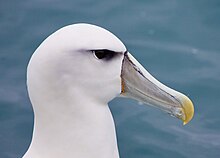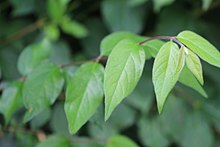흰꼬리신천옹
White-capped albatross| 흰꼬리신천옹 | |
|---|---|
 | |
| 과학적 분류 | |
| 왕국: | 애니멀리아 |
| 문: | 챠다타 |
| 클래스: | 아베스 |
| 주문: | 프로셀라리아목 |
| 패밀리: | 디오메데과 |
| 속: | 탈라사르체 |
| 종류: | |
| 아종: | T. c. 스테디 |
| 삼항명 | |
| 시라사르체 소작균 | |
 | |
흰꼬리알바트로스(Thalassche cauta steadi)는 뉴질랜드 앞바다의 섬에서 번식하는 몰모크이다.모든 전문가들이 이 형태가 수줍은 알바트로스, 탈라사르체 소작종과는 별개의 종으로 인정되어야 한다는 것에 동의하는 것은 아니다.그것은 중간 크기의 검은색, 슬레이트 회색, 흰색 알바트로스이며 몰리모크 [citation needed]중 가장 크다.
분류법
몰리모크는 전갱이, 지렁이, 폭풍우 페트렐, 잠수 페트렐과 함께 프로셀라리목 디오메데아과에 속하는 알바트로스의 일종이다.이들은 특정 식별 기능을 공유합니다.우선, 그들은 나리콘이라고 불리는 윗 부리에 붙어 있는 비강을 가지고 있다.비록 알바트로스의 콧구멍이 지폐의 양쪽에 있지만.프로셀라리폼의 부리는 또한 7개에서 9개의 각질판으로 나뉘어져 있다는 점에서 독특하다.마지막으로, 그들은 왁스 에스테르와 트리글리세리드들로 구성된 위유를 만들어 내는데, 그것은 방심실에 저장된다.이것은 포식자에 대항할 뿐만 아니라 긴 비행 동안 [2]병아리들과 성체들을 위한 에너지가 풍부한 먹이 공급원에 사용됩니다.그들은 또한 비강 위에 위치한 소금샘을 가지고 있고 그들이 흡수하는 많은 양의 바닷물 때문에 그들의 몸을 담수화하는데 도움을 준다.그것은 [3]그들의 코에서 고염수 용액을 배출한다.
흰머리 알바트로스는 수줍은 알바트로스, 타사사르체 카우타, 살빈 알바트로스, 살라사르체 살비니, 그리고 차탐 알바트로스, 타라사르체 에레미타로 구성된 더 큰 알바트로스의 일부입니다.1998년 로버트슨과 넌은 4자 [4]결별을 제안했고, 일부 전문가들은 이에 동의했다.BirdLife International은 2007년에,[5] ACAP는 2006년에,[6] Brooke는 [7]2004년에 각각 동의했습니다.SACC는 3자 분할에 동의했고 스테디만 남겨두고 흰머리 알바트로스는 수줍은 알바트로스와 [8][9][10]함께 묶였다.Clements[11] 분류법은 아직 이 분열들 중 어느 것도 합의하지 못했다.마침내, 브룩을 따라, 이 종은 디오메데아에서 탈라사르체로 옮겨졌고, 이것은 대부분의 전문가들에 의해 일반적으로 동의되었다.
묘사
흰꼬리새의 날개 길이는 평균 90~99cm이고 날개 길이는 220~[12]256cm이다.무게는 3.4~4.[13]4kg이고, 옅은 은회색 얼굴과 어두운 갈색과 대조되는 대담한 흰색 모자를 가지고 있다.어떤 성인들은 끝이 갈색인 깃털이 [14]있는 하얀 등을 가지고 있다.그들은 어두운 회색 맨틀과 검은 꼬리를 가지고 있다.몸의 대부분은 흰색입니다.부리는 옅은 회색에서 파란색에 끝부분이 노란색이다.청소년은 끝이 어두운 회색 부리를 가지고 있으며, 머리는 더 어둡고 목덜미가 회색이다.
범위 및 서식처
| 위치 | 인구. | 날짜. | 트렌드 |
|---|---|---|---|
| 실망의 섬 | 72,000쌍 | 1993 | |
| 오클랜드 섬 | 3,000쌍 | ||
| 안티포즈 섬 | 50~100쌍 | 1994 | |
| 애덤스 섬 | 100쌍 | ||
| 총 | 150,000 | 1993 | 안정적인. |
그들은 뉴질랜드 연안의 섬들의 고유종으로,[15][16] 2007년에 추정된 75,000마리의 번식 쌍과 총 350,000마리에서 375,000마리의 [17]새들을 가지고 있습니다.실망섬은 7만2000쌍, 오클랜드섬은 3000쌍,[17][18] 애덤스섬은 100쌍, 볼론스섬은 100쌍이다.[19]
어린 새들과 번식하지 않는 새들은 남서 대서양에서[20] 먹이를 찾는 것으로 믿어지고 있으며 사우스 조지아 주의 한 새의 최근 DNA 검사에서 [21]확인되었습니다.또한, 과학자들은 다른 기술을 사용하여 그들이 [22][23][24]아프리카 남서부 해안에서 먹이를 찾는다는 것을 증명했다.청소년들은 또한 남대서양과 남서 인도양까지 가는 것으로 알려져 있다.
행동
먹이 주기
그들은 표면 먹이이지만, 물고기, 두족류, 튜넛류,[5] 갑각류 등의 먹이를 위해 얕은 다이빙을 이용할 수 있다.
재생산
흰망토끼는 매년 작은 [5]섬의 바위에서 번식한다.
보존.
국제자연보전연맹(IUCN)은 이 종을 [1]멸종위기종으로 분류하고 있으며, 발생범위는 77,7002,000km(3,000,000평방마일), 번식범위는2 22km(8.5평방마일)이다.이 새의 가장 큰 위협은 긴 줄과 저인망 [16]어업이다.인터넷 모니터 케이블은 많은 사망자를 발생시켰지만 [17][18]1992년에 단계적으로 폐지되었다.배스 해협에서 오징어를 상업적으로 착취하는 것은 식량 공급을 줄임으로써 위협이 될 수 있다.또한, 오클랜드 섬의 돼지들은 1972년부터 1982년까지 둥지를 줄였고, 야생 고양이들 또한 적은 수의 [17][18][25]병아리를 잡습니다.
2006년부터 오클랜드 섬의 새들이 추적되었고, 이것은 [23]계속될 것이다.
각주
- ^ a b c BirdLife International (2008)
- ^ 더블, M.C. (2003)
- ^ 에를리히, 폴 R. (1988)
- ^ 로버트슨 C. J. R. & 넌 G. B. (1998)
- ^ a b c d BirdLfie International (2008a)
- ^ ACAP (2006)
- ^ 브룩, M. (2004)
- ^ 렘센 주니어, J. V. (2004)
- ^ 렘센 주니어, J. V. (2005)
- ^ 렘센 주니어, J. V. (2008)
- ^ 코넬 조류학 연구소 (2018)
- ^ Dunn, Jon L. & Alderfer, Jonathan (2006)
- ^ "White-capped mollymawk". New Zealand Birds Online. Retrieved 18 November 2016.
- ^ 왓킨스, B. (2008)
- ^ Gales, R. 등(1998)
- ^ a b 베이커, G.B. 등(2007)
- ^ a b c d 테일러, G. A. (2000)
- ^ a b c 크록솔, J. P. & Gales, R. (1998년)
- ^ 테니슨, A. 등(1998년)
- ^ 화이트, R. W. 등(2002))
- ^ 팔란, B. 등(2004)
- ^ 애보트, C. L. 등(2006)
- ^ a b 톰슨, D. R. & Sagar, P. M. (2007)
- ^ 로버트슨, C. J. R. 등(2003)
- ^ 톰슨, D. R. & Sagar, P. M. (2006)
레퍼런스
- Abbott, C. L.; Double, M. C.; Gales, R.; Baker, G. B.; Lashko, A.; Robertson, C. J. R.; Ryan, P. G. (2006). "Molecular provenance analysis for Shy and White-capped Albatrosses killed by fisheries interactions in Australia, New Zealand and South Africa". Conservation Genetics. 7 (4): 531–542. doi:10.1007/s10592-005-9064-y. S2CID 35432178.
- ACAP (2007). "Agreement on the Conservation of Albatrosses and Petrels : ACAP Species". ACAP. Archived from the original on January 5, 2009. Retrieved 22 Feb 2009.
- Baker, G. B.; Double, M. C.; Gales, R.; Tuck, G. N.; Abbott, C. L.; Ryan, P. G.; Petersen, S. L.; Robertson, C. J. R.; Alderman, R. (2007). "A global assessment of the impact of fisheries-related mortality on Shy and White-capped Albatrosses: conservation implications". Biological Conservation. 137 (3): 319–333. doi:10.1016/j.biocon.2007.02.012.
- BirdLife International (2018). "Thalassarche steadi". IUCN Red List of Threatened Species. 2018: e.T22729609A132661314. doi:10.2305/IUCN.UK.2018-2.RLTS.T22729609A132661314.en. Retrieved 12 November 2021.
- BirdLife International (2008a). "White-capped Albatross - BirdLife Species Factsheet". Data Zone. Retrieved 22 Feb 2009.
- Brooke, M. (2004). "Procellariidae". Albatrosses And Petrels Across The World. Oxford, UK: Oxford University Press. ISBN 0-19-850125-0.
- Clements, James (2007). The Clements Checklist of the Birds of the World (6th ed.). Ithaca, NY: Cornell University Press. ISBN 978-0-8014-4501-9.
- Croxall, J. P.; Gales, R. (1998). "Assessment of the conservation status of albatrosses". In Robertson, G.; Gales, R. (eds.). Albatross biology and conservation. Chipping Norton, Australia: Surrey Beatty & Sons.
- Double, M. C. (2003). "Procellariiformes (Tubenosed Seabirds)". In Hutchins, Michael; Jackson, Jerome A.; Bock, Walter J.; Olendorf, Donna (eds.). Grzimek's Animal Life Encyclopedia. Vol. 8 Birds I Tinamous and Ratites to Hoatzins. Joseph E. Trumpey, Chief Scientific Illustrator (2nd ed.). Farmington Hills, MI: Gale Group. pp. 107–111. ISBN 0-7876-5784-0.
- Dunn, Jon L.; Alderfer, Jonathan (2006). "Albatrosses". In Levitt, Barbara (ed.). National Geographic Field Guide to the Birds of North America (fifth ed.). Washington D.C.: National Geographic Society. p. 80. ISBN 978-0-7922-5314-3.
- Ehrlich, Paul R.; Dobkin, David, S.; Wheye, Darryl (1988). The Birders Handbook (First ed.). New York, NY: Simon & Schuster. pp. 29–31. ISBN 0-671-65989-8.
- Gales, R.; Brothers, N.; Reid, T. (1998). "Seabird mortality in the Japanese tuna longline fishery around Australia, 1988-1995". Biological Conservation. 86: 37–56. doi:10.1016/s0006-3207(98)00011-1.
- Phalan, B.; Phillips, R. A.; Double, M. C. (2004). "A White-capped Albatross, Thalassarche [cuata] steadi, at South Georgia: first confirmed record in the south-western Atlantic". Emu. 104 (4): 359–361. doi:10.1071/MU03057. S2CID 83493045.
- Remsen Jr., J. V.; et al. (December 2004). "Proposal #155 to South American Check-list Committee: Split Shy Albatross Thalassarche cauta into two or three species". South American Classification Committee. American Ornithologists' Union. Retrieved 18 Feb 2009.
- Remsen Jr., J. V.; et al. (February 2005). "Proposal (#166) to South American Classification Committee: Re-lump Thalassarche eremita and Thalassarche salvini with Thalassarche cauta". South American Classification Committee. American Ornithologists' Union. Retrieved 18 Feb 2009.
- Remsen Jr., J. V.; et al. (28 Feb 2008). "Proposal (#255) to South American Classification Committee : Follow-up to Proposal 155: Split Thalassarche cauta into three species". South American Classification Committee. American Ornithologists' Union. Retrieved 18 Feb 2009.
- Robertson, C. J. R.; Bell, D.; Sinclair, N.; Bell, B. D. (2003). "Distribution of seabirds from New Zealand that overlap with fisheries worldwide". Science for Conservation. Wellington, New Zealand: Department of Conservation. 233.
- Robertson, C. J. R.; Nunn, G. B. (1998). "Towards a new taxonomy for albatrosses". In Robertson, G.; Gales, R. (eds.). Albatross biology and conservation. Chipping Norton, Australia: Surrey Beatty & Sons. pp. 13–19.
- Taylor, G. A. (2000). "Action plan for seabird conservation in New Zealand. Wellington: Department of Conservation". Threatened Species Occasional Publication. 16.
- Tennyson, A.; Imber, M.; Taylor, R. (1998). "Numbers of Black-browed Mollymawks (Diomedea m. melanophrys) and White-capped Mollymawks (D. cauta steadi) at the Antipodes Islands in 1994-95 and their population trends in the New Zealand region". Notornis. 45: 157–166.
- Thompson, D. R.; Sagar, P. M. (2006). "Conduct a population and distributional study on White-capped Albatross at the Auckland Islands". Unpublished Annual Report to the Conservation Services Programme, Department of Conservation.
- Thompson, D. R.; Sagar, P. M. (2007). "Conduct a population and distributional study on White-capped Albatross at the Auckland Islands". Unpublished Annual Report to the Conservation Services Programme, Department of Conservation.
- Watkins, B. (2008) (라이트)
- White, R. W.; Gillon, K. W.; Black, A. D.; Reid, J. B. (2002). The distribution of seabirds and marine mammals in Falkland Islands waters. Peterborough, U.K.: Joint Nature Conservation Committee.





